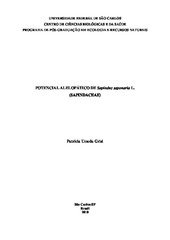Potencial alelopático de Sapindus saponaria L. (Sapindaceae)
Abstract
Studies on allelopathy have been important in understanding the processes by which plants influence their neighborhood by releasing substances of secondary metabolism and its application in agriculture, forestry systems and ecosystem management. The objective of this study was to evaluate the allelopathic potential of aqueous extract of root, fruit, young and senesced leaves of Sapindus saponaria L. (soapberry) on the germination of seeds and morphology of seedlings vegetables (Lactuca sativa L. and Allium cepa L.) and weed (Echinochloa crus-galli (L.) Link and Ipomoea grandifolia (Dammer) O Donell). Moreover, was evaluated by fractionation biodirigido, the allelopathic activity of different fractions of extracts from young leaves of Sapindus saponaria on the growth of wheat coleoptile (Titicum aestivum L.). The aqueous extract was prepared using 100 g of plant dried or fresh material + 1000 mL of distilled water, resulting in the concentrated extract (10%). The dilutions were made with distilled water to 7,5; 5,0 and 2,5%. The extracts showed allelopathic potential changing according to the receiver species. The inhibitory effect on the process of germination of the seeds and seedling morphology receptor was concentrationdependent. The leaf extract caused greater inhibitory effect on germination, while the extracts of the fruit and young leaves were the most inhibited seedling development. Chemical analysis of young leaves of Sapindus saponaria, showed that the fraction of ethyl acetate showed higher allelopathic activity on the wheat coleoptile and that it can be found on the compounds responsible for this inhibition.
